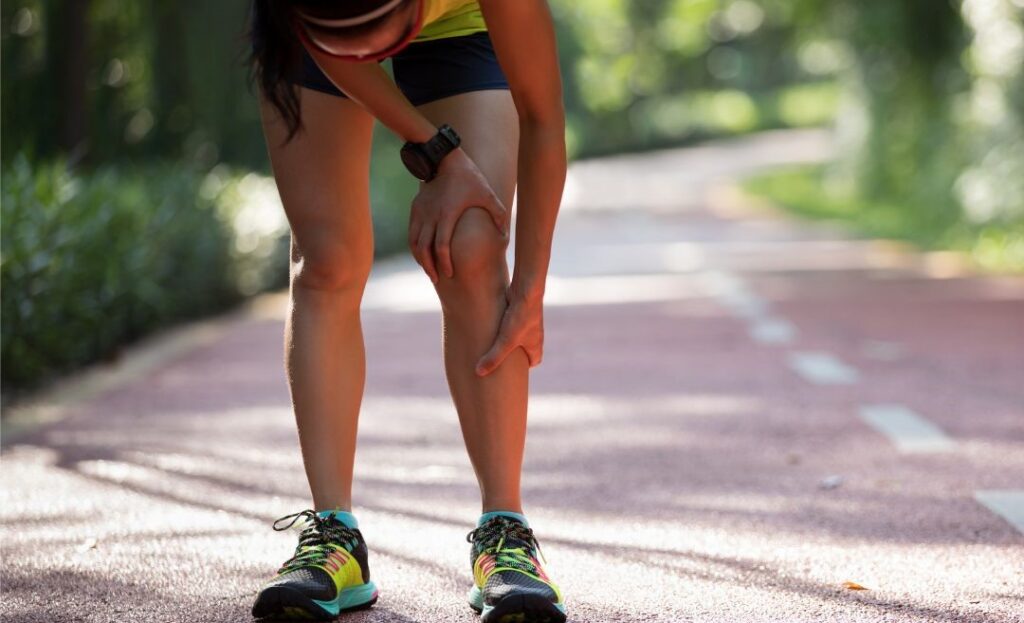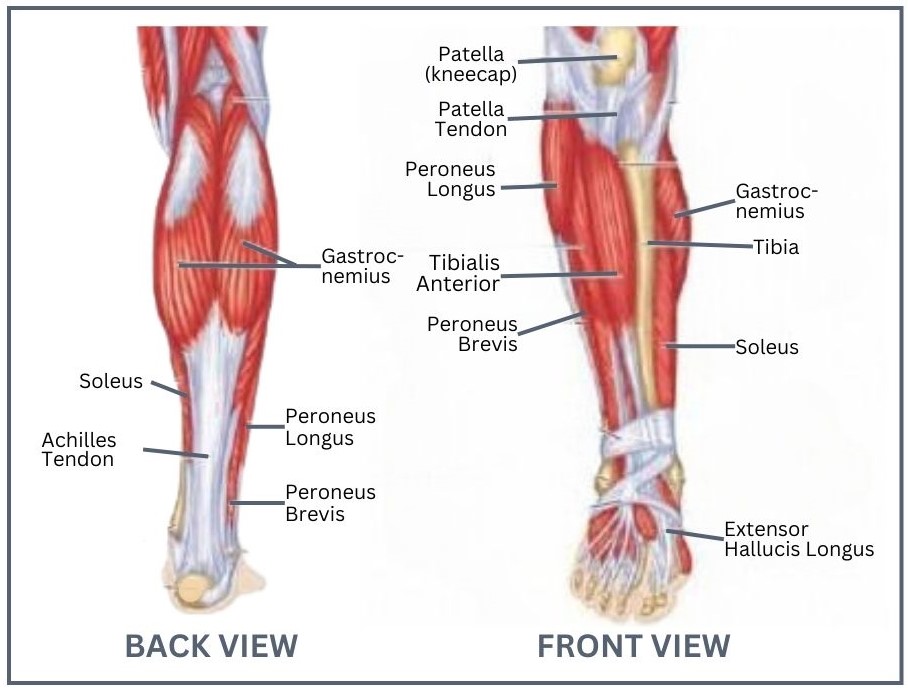
Shin pain is a common problem we see in runners of all abilities, from recreational to elite level. If not managed well it can lead to the dreaded stress fracture, which means considerable time out of running (and usually lots of frustratingly long sessions on a bike!) so any new information we get about how to prevent and manage it better is very welcome. A study by Mattock et al in 2021 shows that shin pain produces significant deficits in lower leg muscle strength and endurance, so lets break down the results and see how it affects how we manage shin pain in runners
What Causes Shin Pain in runners?
Medial tibial stress syndrome (MTSS), more commonly known as shin splints, is the most common cause of shin pain in runners. It involves pain along the inside of the shin bones (tibia) felt during and after running. It is produced by inflammation of the muscles, tendons, and bone tissue around the inner side of the shin bone, usually in the mid to lower shin area. The pain is caused when these tissues get overloaded, usually by increasing your running volume too quickly.
It’s important to separate MTSS from bone stress and stress fractures because they may be managed quite differently. We already have more detailed information on how we diagnose and manage these different injuries – click the blog links below to read more. So, for the rest of this article we’ll just be talking about shin pain caused by MTSS.
What Are The Risk Factors For Getting Shin Pain (MTSS) When Running?
Numerous potential risk factors have been identified for MTSS including increased navicular drop (which is a measure of pronation or flattening of your arch in weightbearing), higher BMI (body mass index), less years of running experience, being female, having a history of MTSS, and having smaller calf muscle bulk (lean lower leg girth). While it’s good to know these risk factors, the frustrating thing is that many of them are Unmodifiable Risk Factors – they cannot be changed – for example if you’re female, or new to running or have already an episode of MTSS in the past, we can’t really change these.
So How Does This Study Help Us Manage Shin Pain In Runners?
The aim of this study was to see if weakness in the lower leg muscles (mainly the calf muscles), was related to MTSS shin pain in runners. The benefit of this area of research is that calf muscle strength is a Modifiable Risk Factor – i.e. it can be changed – so if a link is made between calf muscle weakness and shin pain when running then we can do something about it!
What Did The Research Show?
If you would like all the details of the results then feel free to look at the original article, because there are some subtle points that are relevant. But for this article I wanted to keep it simple, so I’ll just summarise the big take-home message for runners like this:
The main muscles related to running were significantly smaller, weaker and had less endurance in the runners with shin pain (MTSS) than in runners without shin pain.
That is the main message I’d like you to take away from reading this post. And the obvious next step from this finding is that increasing the strength of your lower leg muscles is important in the treatment of MTSS in runners. Once your pain settles down enough, doing targeted exercises to increase the size, strength and endurance of the main running muscles in your lower leg should be the foundation of your rehab program.

Which Are The Main Muscles You Need To Strengthen For Shin Pain When Running?
The study showed that really we need to strengthen all of the major lower leg muscles that are related to running. The soleus is the primary calf muscle involved in endurance running, so doing soleus raises and bent-knee calf raises are really important. Increasing plantar plexor endurance (i.e. your ability to do repeated calf raises) was also shown to be necessary, which relies on the soleus as well as the other main calf muscle, the gastrocnemius (gastroc), so doing repeated calf raise training should be included, preferably with increasing weight.
Interestingly, the flexor hallucis longus and tibialis anterior muscles were also shown to be significantly weak in runners with shin pain. These muscles are often overlooked in shin pain rehab programs, but the proposed theory is that, because they both play a role in supporting the arch of the foot, weakness in these muscles allows the arch to drop (i.e. increased pronation), which is a risk factor for MTSS. So, strength exercise protocols for MTSS pain should also include strengthening of these two muscles.
Will Strengthening Your Calf Muscles Prevent Shin Pain or MTSS?
Well, while this may well be true, and we’d love to be able to say that just increasing your lower leg and calf strength will stop you getting shin pain, we can’t really say that just based on this study. That’s because this study only looked at what runners muscles were like after they got shin pain. Did they only become weak after their pain began (i.e. did their pain cause their weakness to develop), or were they weak before their pain began (in which case maybe their weakness caused their pain to develop). However, while we can’t make clear cause-and-effect assumptions from only this study, there is solid evidence showing that strength training has a very protective effect against injuries with running. Click to see our full post on this subject.
Calf Strength Exercises For Runners
Ok, so now we know that increasing the strength of our calf and lower leg muscles is important in the treatment of MTSS shin pain in runners, and we think it may also help in preventing shin pain in the first place, what should we do? Well, this is already a long post, and there are lots of options about how to strengthen your leg muscles for running, so I’m going to save that for a separate post which will come out in the near future. but in the mean time a good place to start would be;
- straight leg weighted calf raises
- seated soleus raises
- single-leg deadlift
- T Rex Walks (try them – they’re fun!)
Need Help With Shin Pain When you Run?
Central Performance Running Centre
The Central Performance Running Centre delivers everything a runner needs in one great location. Our dedicated team of running physios, run coaches and running strength & conditioning trainers love working with runners of all abilities and experience. Every day we work with runners from beginner level through to state, national and international athletes.
Meet Ben Liddy – Head Of Running Performance
Ben, one of our directors, comes from an elite running background and heads up the Central Performance Running Centre. He is a certified Level 4 World Athletics Running Coach, and leads our team to ensure that every runner we see is managed like an elite athlete. As well as coaching our invitation-only junior and senior running groups, Ben works with our team to continuously improve the 3 service areas provided by the Running Centre
1. Running Physio: our team of expert running physios are continuously updating their skills and knowledge to ensure that you get the best and fastest possible recovery from injury. Our particular expertise lies in managing common running injuries such as knee pain, shin pain, tendinopathy (Achilles, patellar, hamstring, tib post), bone stress injuries (stress reaction, stress fractures), and foot and heel pain (plantar fasciopathy…). Whenever possible we keep you running as you recover – we know runners hate not being able to run!
2. Running Coaching: Want to feel what it’s really like to run well, with a more efficient gait that lets you run faster for longer with less chance of injury? Then our unique RunRight program is just what you’re looking for.
3. Running Strength & Conditioning Programs: Research shows that having a targeted and professionally programmed strength program can vastly improve your running performance, plus significantly reduce your risk of injury. Our running strength and conditioning coaches are all degree-qualified Exercise Physiologists with specific experience and expertise in working with runners of all abilities to improved performance and reduce their risk of injury. You can come and train in the clinic with us, or if you already have a gym membership but aren’t sure which exercises you need to be doing, we can program your sessions for you to do independently.
If you have any questions or want to chat to one of our running physios for some free advice, feel free to call us on 9280 2322 or hit the Contact Us button. You can also book online if you have an issue that you’d like some help with.
REFERENCE: Mattock, J., Steele, J., and Mickle, K. Lower leg muscle structure and function are altered in long-distance runners with medial tibial stress syndrome: a case control study. Journal of Foot and Ankle Research (2021) 14:47

